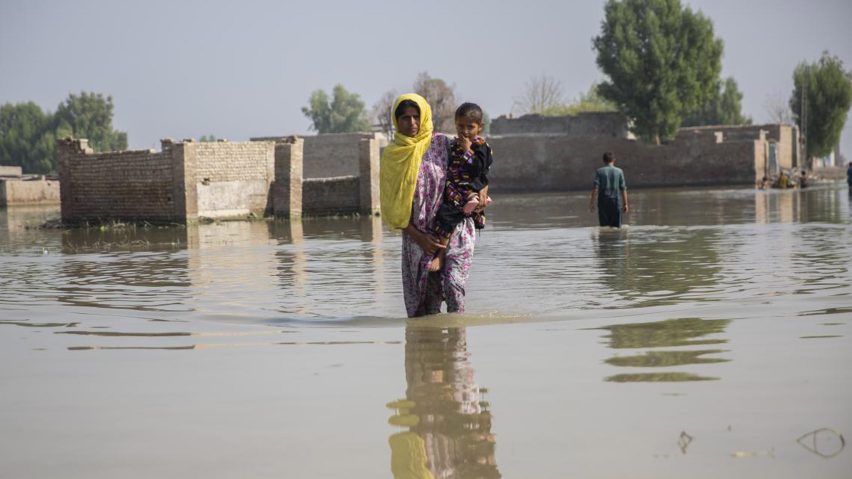
"It is time for all of us to become aware of the gravity of the situation"
Continuing our Designing for Disaster series, Yasmeen Lari warns that architects in the Global North cannot ignore the threat from environmental hazards exacerbated by climate change.
As built environment professionals and as architects, are we aware that we are aggravating climate change because of the way we design and build? All around the world, most architecture practices continue to indulge in extravagant imagery that can only be actualised using carbon-emitting industrialised materials.
Unless architects begin thinking of democratising and decarbonising architecture, the ultimate outcome will remain the edification of our own egos in the service of privileged entities – even when many of us might be conscious of the damage inflicted on the planet by our uncurbed creativity.
I am pleading for sanity to prevail
Is it not time for architects, considered among the most environmentally sensitive professionals, to become eco-ethics activists? Instead of attempting to fulfil the desires of the wealthy, should we not sensitise our clients to the needs of the earth's ecosystem that today needs critical care for its survival?
I had the advantage of becoming aware of the severity of the situation several years ago, since my country, Pakistan, is among the five most vulnerable countries. It has been suffering from frequent disasters over the past few decades. Last year alone we suffered from the most devastating floods which displaced 33 million people – more than the entire population of Australia and half the population of the UK.
But then is it fair that the Global North should continue to indulge in eco-bigotry and high-carbon undertakings while countries such as Pakistan, responsible for only 1 per cent of global greenhouse-gas emissions continue to endure the brunt of climate change?
I am not attempting to make a case for reparations for the losses suffered by frontline climate-change states. Nor do I wish to seek payments from high emitters responsible for untenable emissions levels. In my view, such demands carry tacit approval of unethical proposals propounded by eco-indulgent countries for pacifying resource-deficient countries in the Global South.
Rather, I am pleading for sanity to prevail in order that we relinquish the desire to exploit the planet for the benefit of a handful of individuals and nations driven by consumption-loving lifestyles. It is time for all of us to become aware of the gravity of the situation.
Today, it is Pakistan where one-third of the country is going through the cycle of misery, hunger and disease, but tomorrow it could well be many other countries, who have so far escaped the grievous impact. When I visit countries such as the UK and the USA, I am struck by how many cities are now suffering from urban heat islands and urban flooding.
It is professionals such as ourselves who carry the responsibility
It is time to work on fashioning a new world order where the convenience for a few should no longer hold sway over the benefit for the majority. Especially under the present circumstances, where urban centres that emit 65-70 per cent of greenhouse gases must be rescued from becoming global-warming battlegrounds.
There are alternatives available to us. As we know, many experts around the world are supporting the creation of eco-cities, eco-urbanism, sponge cities, de-growth, transition design and principles of circular economy, including reuse of all buildings, even contemporary buildings. It is well known that 40 per cent of emissions are due to the use of industrial materials and current construction methodologies.
It is professionals such as ourselves who carry the responsibility to ensure the lowering of the carbon footprint in all that we design. It is clear that curtailing the use of cement and steel and other industrialised products will help us reach that elusive figure of 1.5 degree Celsius rise per year echoed by various Conferences of the Parties assemblies since the historic Paris Agreement in 2015.
We can make our urban centres liveable again. In Karachi, I have embarked on a city-wide programme called Climate-Smart Eco-Streets. Since it is difficult to take up entire city quarters, we are in the process of transforming one street at a time.
We use low-carbon, permeable terracotta pavements that help mitigate flooding and cool the environment in place of high-carbon, impervious concrete pavers. We restrict the demolition of existing buildings and prevent motorised vehicles from entering. We plant dense, Miyawaki-style dense urban forests that absorb CO2, provide shade and boost biodiversity, supported by wells to conserve storm water, keeping the soil fertile while also preventing flooding.
After my Foundation created the first eco-street, Denso Hall Rahguzar walking street in the historic core of Karachi in 2021, the Karachi administration has realised how simple, localised solutions can prevent urban flooding and forestall the formation of urban heat islands. At the same time, a climate-resilient, healthy environment is benefitting all users, encouraging tourism, commerce and cultural activities.
I am optimistic that we will be able to recreate humanistic eco-environments
By adopting the above simple principles and low-tech, low-impact options, many urban centres of the world would be able to mitigate the impact of climate change, and would become liveable again.
Remember: cities are for people and not for cars, nor extensive highways or imposing structures that undermine human scale and inhibit human interaction. By making streets into climate-smart eco-streets, I am optimistic that we will be able to recreate humanistic eco-environments harking back to the community living of the medieval towns of Pakistan and Europe.
Yasmeen Lari is the founder of the Heritage Foundation of Pakistan. She was Pakistan's first female architect and the recipient of the 2023 RIBA Royal Gold Medal.
The photography is by UNICEF/Bashir.

Designing for Disaster
This article is part of Dezeen's Designing for Disaster series, which explores the ways that design can help prevent, mitigate and recover from natural hazards as climate change makes extreme weather events increasingly common.